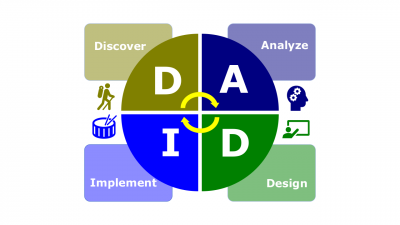DREPD
DADI (also known as DADI pattern; hereinafter, the Pattern) is the enterprise development nesting pattern that divides enterprise development activities in four consecutive batches: Discovery (D), Analysis (A), Design (D), and Implementation (I). The name of the Pattern is the abbreviation of four verbs: Discover, Analyze, Design, Implement.
The Pattern is used in any development in two ways:
- Being complex, Pattern can serve as a canvas for the development cycle as a whole. In this case, one bigger complex Pattern may consist of a number of smaller Patterns, which are called basic; and
- Being basic, Pattern can serve as a layout for simple actions in new product development, problem solving, competitive strategy, business analysis, systems engineering, project management, etc. A combination of those basic Patterns can be presented as a complex Pattern.
In education, Bracka School also deploys the Pattern while building the curricula on multiple sets of four quarters, each of which represents one batch of the Pattern.
Contents
Components
Enterprise discovery
- Main wikipage: Enterprise discovery
- The first batch of the Pattern is Enterprise discovery. It includes all activities resulted in discovery of any data relevant to the further enterprise development. These data include some statement of the business need that is sought to be satisfied as the key outcome from that enterprise as a whole.
Enterprise analysis
- Main wikipage: Enterprise analysis
- The second batch of the Pattern is enterprise analysis. It includes all activities needed to process the data discovered in enterprise discovery in order to provide enterprise design with detailed requirements for the future outcome from the Pattern.
Enterprise design
- Main wikipage: Enterprise design
- The third batch of the Pattern is enterprise design. It includes all activities needed to conceptualize, design, scratch, model, map, plan, project, and/or detail the Pattern's outcome and/or finalize the architecture or layout for this outcome.
Enterprise implementation
- Main wikipage: Enterprise implementation
- The fourth batch of the Pattern is enterprise implementation. It includes all activities needed to create and deliver the Pattern's outcome based on its architecture or layout made in enterprise design.
Applications
New product development, problem solving, competitive strategy, portfolio management, business analysis, systems engineering, project management and many other concepts are built on the basic Patterns. Complete complex terminal Patterns seem to have strong correlations with other concepts as well.
In project management
- With one exception of discovering a business need, which project deliverables shall satisfy, the complex Pattern can serve as a project management canvas itself. One or more the basic Patterns can be used in order to create or modify any output of any project management process such as a project charter, stakeholder register, acceptance criteria, etc.
Complex Patterns vs other development concepts
- Although the table below is not intended to be complete, it addresses some tendencies and correlations between the complete complex terminal Patterns, on the one hand, and some other other development concepts, on the other hand:
Discovery Analysis Design Implementation Business need Requirements data Portfolio management Usually, c-level executives define the needs at the organizational level, as well as frontline managers at the lower levels and middle managers in between those levels New product development Project management Systems engineering Usually, project teams or functional departments execute implementations Business analysis Solution architects or others can design the solution Competitive strategy Business need Requirements data Analysis Design Implementation Discovery
In education
- Bracka School has built its Septem Artes Administrativi curriculum on seven sets of four quarters. Each set is called quadrivium and designed around the Pattern.
